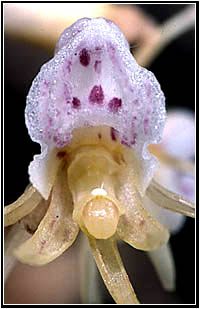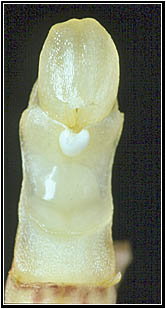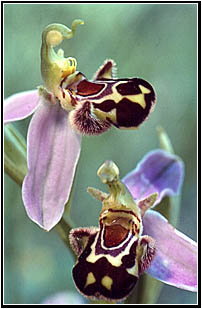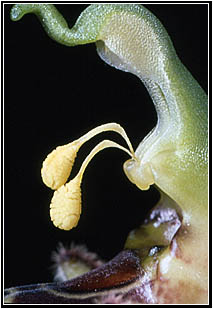|
The
form and the function gynostemium of the European Orchids
|
Jean
Claessens and Jacques Kleynen are nature photographers
specialized in extreme macro photography. They have been studying
orchids since twenty years ago. At about 1990, they become interested
in the genus Epipactis photographing all species. Since them,
they regularly publish articles concerning the results of their
field researches, such as "Het geslacht Epipactis
in de Benelux: bloembiologische beschrijvingen en soorttypische
kenmerken - Eurorchis 3: 5 - 38 (1991)", "Investigations
on the autogamy in Ophrys apifera Hudson. Jber. naturwiss.
Ver. Wuppertal 55, 62-77", " Anmerkungen zur Hybridbildung
bei Platanthera bifolia und P. chlorantha (in print)
(2005), among many others.
|
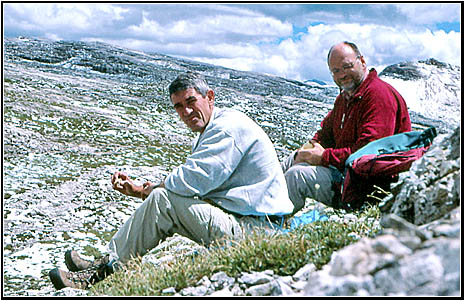 |
ON:
You're nature photographers
specialized in extreme macro photography and your lecture concerned
the European Orchids. What came first: the photography or orchids?
JC & JK: At first came photography. If you
are interested in orchids, in Europe you inevitably have to take pictures,
because all orchids are protected by law, and cannot be grown in a greenhouse.
But the great charm of orchid searching is being in nature and enjoying
the beautiful landscapes and rich flora of the orchid sites.
ON: How long have you been studying orchids?
JC & JK: We have been studying orchids since
about 1985, at first we wanted to get to know all orchid species and
traveled throughout Europe, but soon we got more interested in the scientific
aspects of the orchids. Our investigations concerning the gynostemium
were based on curiosity: we wanted to know what was the base of classification,
and so we learned, that the morphology of the gynostemium is (was…)
crucial in orchid classification.
ON:
How long have you taken to do the research concerning the Gynostemium
of the European Orchids, subject of your lecture in Dijon?
JC & JK: At about 1990 we got a special interest
in the genus Epipactis, and decided to photograph the gynostemia
of all Epipactis species. The lecture that resulted from those
investigations was quite appreciated, and gave us the idea to do the
same for all European orchid genera. In 1995 we published an article
< Claessens, J. & Kleynen, J. (1995): Die Systematiek der europäischen
Orchideen, illustriert an Hand von Makro-Fotos - Jour. Eur. Orch. 27
(1): 93 - 124. > , and afterwards, in 1997, we presented our results
at the “Wuppertaler Orchideentagung”, a orchid congress
in Wuppertal. It took quite some time and training getting acquainted
with the extreme macro photography, but it is a quite fascinating field
that enables one to discover normally hidden aspects of flower morphology.
ON:
You said that most descriptions of gynostemia of European orchids are
based on alcohol preparation. And about your research?
JC & JK: Since we are amateurs, most of our
orchid studies took place during holidays. We always take with us a
binocularly microscope and with the help of this we could study the
flowers of all orchid genera from fresh material.
ON:
Which are the facts that you gathered examining fresh flower material
concerning the morphology of the gynostemia and their function?
JC & JK: We found, that some aspects of the
gynostemium could only be studied on fresh material. A good example
for this is the development of the gynostemium of Corallorhiza trifida,
which will be discussed in our contribution to the annals of the congress.
This approach also enabled us to understand more about the exact functioning
of the gynostemium, important for the full understanding of the pollination
biology. Fresh material enables you e.g. to observe the speed of caudicle
bending after it has been removed from the anther. Our observations
showed e.g., that in Ophrys apifera, an autogamous species, gusts
of wind that make the pollinia sway, play a vital role in pollination
(see our article “Investigations on the autogamy in Ophrys
apifera Hudson. Jber. naturwiss. Ver. Wuppertal 55, 2002)
ON:
Which countries does your research enclose?
JC & JK: Most European countries, for some
species are restricted to specific areas, e.g. Habenaria tridactylites
can only be studied on the Canarian Islands. And for Steveniella
satyroides one has to go to Turkey. But that was one of the charms
of our researches: we got to know many countries with their own orchid
flora.
ON:
Which are the European genera have you worked about, besides Cephalanthera,
Corallorhiza, Epipogium and Ophrys?
JC & JK: We studied all European orchid genera,
that is 36 genera if one takes the “old” classifications.
Even if nowadays some genera are (re)united, we had to study them for
ourselves in order to form our opinion on the genera. At the moment
we are working on a publication on all European orchid genera, and we
hope to finish this by the end of 2006.
ON:
You should visited many habitats to achieve your work. What could you
tell about their characteristics?
JC & JK: In Europe one finds only terrestrial
species, and most European orchids can be found on calcareous ground.
Many of our investigations were made in the south of Europe, that is
France, Italy and Spain. In those countries there are large calcareous
areas, which still have a fairly undisturbed flora, although the influence
of man is omnipresent. Many orchids depend on mans activities, above
all the pasture with sheep, which keeps the landscape open and provides
thus suitable growing places for many orchids. In the densely populated
regions as e.g. Holland, the orchid growing places are mostly restricted
to nature reserves.
ON:
In the literature, there are some controversial in the data about the
number of species occurring in Europe. Which is your conclusion about
that?
JC & JK: In Europe there is a great devaluation
of the species concept. Due to modern means of transport orchid lovers
travel a lot and can visit many orchid sites, which show the variability
of the species and genera. But there is a trend to attach much importance
to minor differences, ignoring the variability. This results in a continuous
flood of new “species”. All “new” taxa are given
the specific rank, thus making it very hard to see relations between
taxa. This has lead to an enormous mix-up of species, which urgently
needs a thorough revision, in which in our opinion most new species
will end up in synonymy.
ON:
Which are the most widely spread species in Europe?
JC & JK: Orchis and Ophrys
are widespread genera.
ON:
What can you tell about the conservation of orchids in Europe?
JC & JK: In general, orchids are well protected
by law, and there is a good awareness of the importance of orchids as
indicators of a sound environment. Unfortunately, in politics environment
is no longer the most important topic; the recession is first priority,
and so nature conservation is not as important to the government as
it used to be.
ON: Thank you, Jean Claessens and Jacques Kleynen!
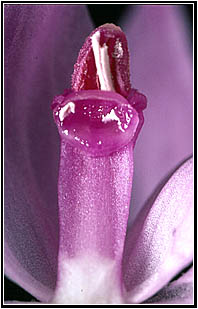 |
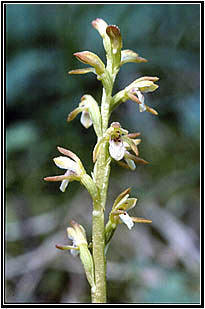 |
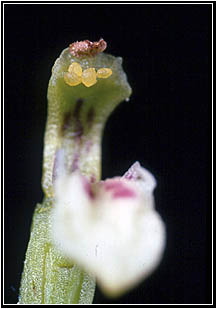 |
|
Cephalanthera
rubra gynostemium
|
Corallorhiza
trifida
flower
|
Corallorhiza
trifida
gynostemium
|
|
|
|
|
|
|
Epipogium
aphyllum flower
|
Epipogium
aphyllum gynostemium
|
Ophrys
apifera flower
|
Ophrys
apifera gynostemium
|
Photos
by Jean Claessens and Jacques Kleynen
|
Any
kind of reproduction (print, digital or anyone other) of any
type of material of this site - texts, layout, photos, images
and others - is strictly forbidden without previous written
permission by the authors.
|

|




